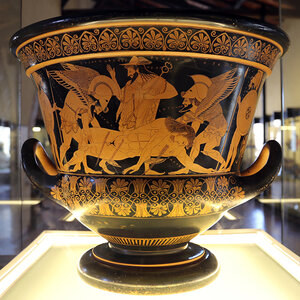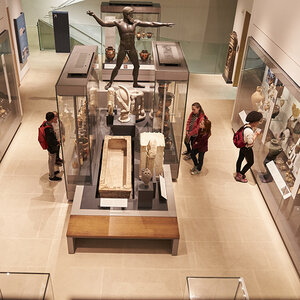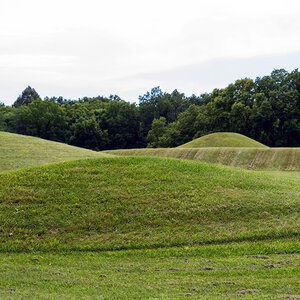Loot: The Battle Over the Stolen Treasures of the Ancient World
In Loot: The Battle Over the Stolen Treasures of the Ancient World, Sharon Waxman, a former reporter for the New York Times, examines the tricky issue of antiquity acquisition and repatriation and, in the process, indicts some of the world's greatest museums for their willful and ongoing deceit about the provenance of many of the ancient works of art in their collections.
According to Waxman, provenance of such pieces was considered secondary to their authenticity under the "don't ask, don't tell" regime that prevailed among curators and museum directors for decades — a lapse abetted by an incurious public. Only recently did this unofficial policy give way to strict UNESCO-brokered standards in museum acquisitions. Repatriation is of recent vintage, too, and it continues to make news as Egypt, Italy, and other nations go public with demands for the return of clearly plundered objects. Wronged nations have become media-savvy, their claims often buttressed by embarrassing evidence that museum officials — including those at New York 's Metropolitan Museum of Art — were fully aware that what they were buying was indeed...loot.
A reader-friendly account, Loot tells the story of such famed plunder as the Euphronios Krater, a large, exquisitely decorated, 2,500-year-old tureen that the Met returned to Italy last year, and the bust of Nefertiti. Waxman's account is enlivened by gossipy detail, helpful photographs, and expert storytelling and reporting. As background for current controversies, it also recounts the histories of such culture meccas as the Louvre — a former hunting lodge — and the Met, many of whose first antiquities came from archaeological digs sponsored by Louis Palma de Cesnola, a Civil War veteran who became U.S. consul to Cyprus.
While in Cyprus, Cesnola planned to ship nearly four hundred artifact-laden packing crates to New York, but the ruling Ottomans got wind of his scheme and ordered that "the U.S. consul" be allowed to do no such thing. So Cesnola simply shipped the crates as the property of the Russian consul.
Cesnola, who became director of the Met, eventually collected 35,573 ancient objects, some of whose provenance remains unclear. In 1893, a German archaeologist searched for the temple and funerary chamber that Cesnola said had yielded many of his treasures. The temple, the archaeologist concluded, existed only in Cesnola's "imaginative mind." The Met, Waxman says, explains this away as "a mystery."
For those who haven't followed the repatriation debate — or haven't read the memoirs of certain museum directors — some sections of the book are sure to raise eyebrows. The book's section on the Met, for instance, is titled "Tomb Robbers on Fifth Avenue," and in it Waxman quotes Thomas Hoving, former Met director and now confirmed "restitutionist":
"I bought a lot of smuggled stuff....My favorite story to get something out of Italy was to bring the children in a station wagon, put mattresses on the back in the hottest day of August and leave with this stuff under the mattress. Just before going to Customs. you'd give the kids ice cream cones. And the Customs officials in their dress whites, you can't imagine how fast they'd put you through....You did it because you wanted to boost your collection with beautiful things."
As others have before and since, the British Museum in 1998 declared that it no longer would buy ancient "beautiful things" without clear provenance — a move that Waxman applauds. In contrast, she devotes considerable space in her section on the museum to the Elgin Marbles, whose provenance is only too clear. Britain's Lord Elgin — a rescuer of priceless antiquities to some and a looter to others — never had clear authority from the ruling Ottomans to dismantle parts of the Parthenon and crowbar-out the many sculptures that wound up in the British Museum. The current revisionist view, Waxman says, is that the Elgin Marbles were removed "to safeguard beautiful things on behalf of the world." But Greece now is building the New Acropolis Museum at the base of the Parthenon specifically to house, and safeguard, the Elgin Marbles, mooting any British argument that they can't be repatriated because the Greeks have no proper place for them. The real fear, Waxman says, is that repatriating them and other treasures "would open the door to the emptying not only of the British Museum but of all the great museums of the world."
The British Museum also is "home" to the Rosetta Stone, dug up in Egypt by French soldier-laborers under the command of Napoleon and handed over to the British in the early years of the nineteenth century. No one at the time thought to ask the Egyptians if they minded. They did, and now they want it back. Nothing doing, say the Brits. The feeling is that the Rosetta Stone, Elgin Marbles, and other relics of ancient civilizations belong in a "universal museum" where, the argument goes, they can be viewed by millions and in the context of multiple cultures. A museum like the British Museum. The Elgin Marbles have been in London since 1802, and there they shall stay. End of discussion.
Waxman is not deaf to the arguments of those now in possession of looted artifacts. She notes, for example, that for now many precious objects are probably better off where they are, since the country of origin may be unable to properly display, preserve, and secure them. A case in point is the 363-piece Lydian Hoard, looted treasure that the Met bought and actually hid. After years of stonewalling, the Met agreed to return the works, but only after it seemed that Turkey would prevail in Manhattan federal court. After repatriation to a small and poorly secured museum, the centerpiece of the hoard — a delicate gold brooch in the form of a winged horse — was stolen and replaced in its flimsy display case by a counterfeit.
The man accused of the theft? The director of the little-visited museum. Indeed, so starved was the museum for funds that the lone security guard doubled as a ticket taker and, until the theft, had no alarm system or working security cameras.
What should be done? Waxman, who holds a master's degree in Middle East studies from Oxford, makes it clear that when it comes to repatriation there are no easy answers, "no clear right and wrong as there was in the case of looted Nazi art." But she does offer several suggestions.
For starters, museums should be more candid in their catalogs, on their Web sites, and in display cards about the provenance — or lack thereof — of antiquities in their collections. They should own up to past misdeeds. Apologies should be offered. By the same token, source countries should accept that some demands may be premature, given their inability to preserve and secure the objects they seek.
As for the road forward, Waxman says it should be one of collaboration between source countries and wealthy nations that have the means and skills to preserve the patrimony of the former — at least for now.










